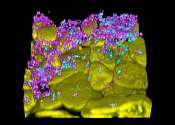An infection is the detrimental colonization of a host organism by a foreign species. In an infection, the infecting organism seeks to utilize the host's resources to multiply, usually at the expense of the host. The infecting organism, or pathogen, interferes with the normal functioning of the host and can lead to chronic wounds, gangrene, loss of an infected limb, and even death. The host's response to infection is inflammation. Colloquially, a pathogen is usually considered a microscopic organism though the definition is broader, including parasites, fungi, viruses, prions, and viroids. A symbiosis between parasite and host, whereby the relationship is beneficial for the former but detrimental to the latter, is characterised as parasitism. The branch of medicine that focuses on infections and pathogens is infectious disease. "When infection attacks the body, anti-infective drugs can help turn the tide of battle. Four types of anti-infective drugs exist: antibacterial, antiviral, antitubercular, and antifungal. A secondary infection is an infection that occurs during or following treatment of another already existing primary infection.









